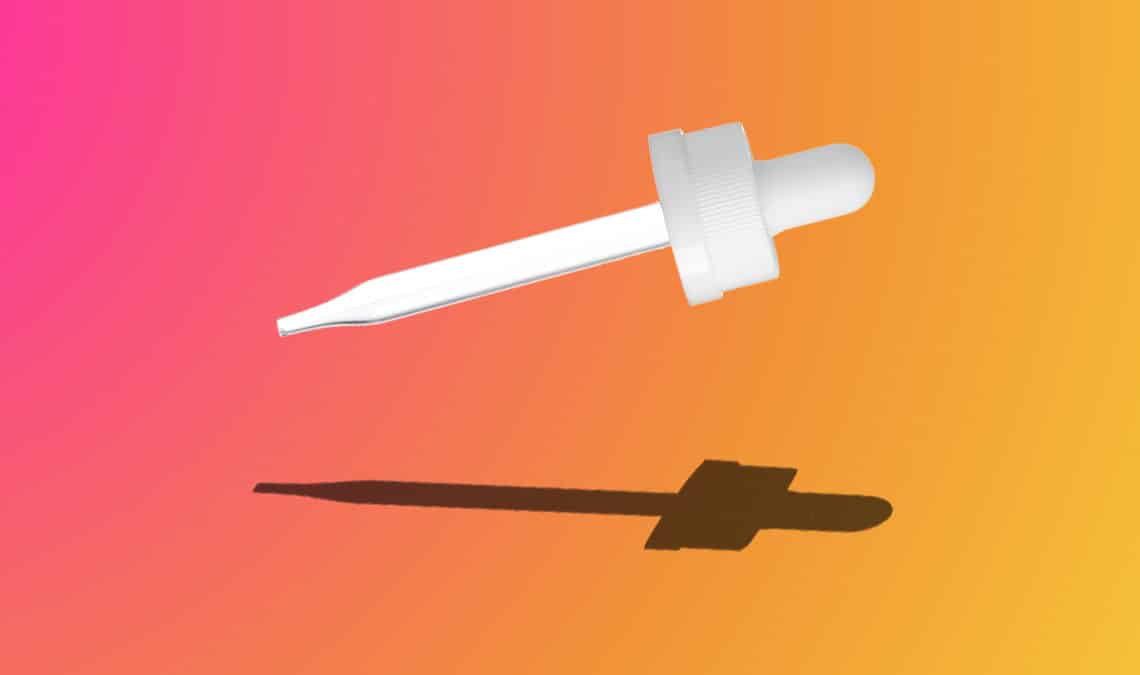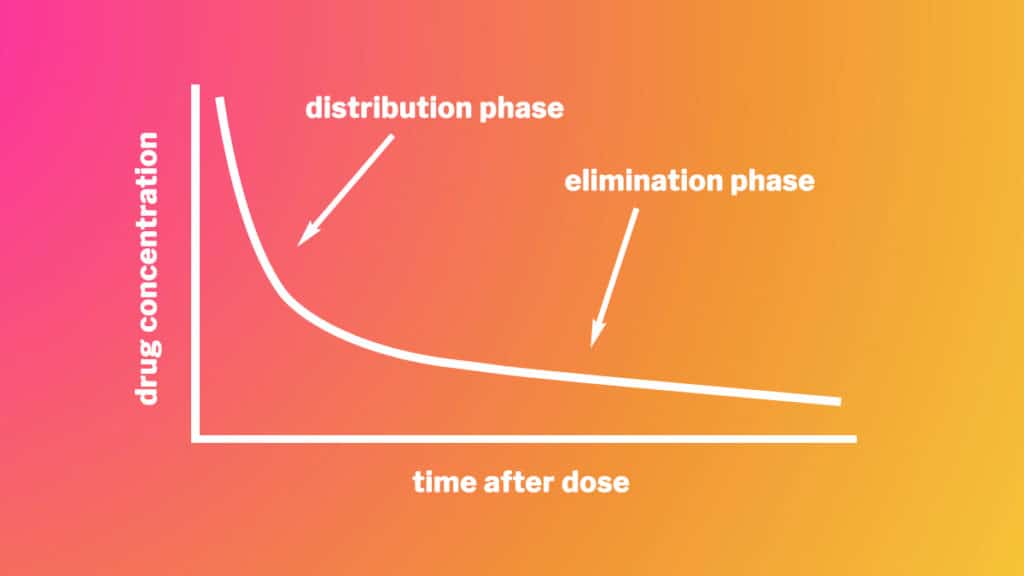
Short answer: CBD has a half-life of 16 to 48 hours after a single dose and 2 to 5 days after regular usage, when blood concentrations have reached a high level.
Many people take CBD for its potent anti-inflammatory and mood-boosting properties. But there’s clearly a lot of confusion about how long CBD actually lasts.
A quick look at Wikipedia, or a quick research review, will tell you that CBD typically has a half-life of 16 to 32 hours. Most people, however, misunderstand what that means, and how drug half-lives work.
Furthermore, the route of administration–oral, transdermal, inhaled, and so on–also affects the duration of CBD’s effects.
In this article I’ll explain how drug half-lives actually work, the differences between different routes of CBD administration, how long CBD stays in your system, and how long its effects really last.
One thing I do want to note is that while CBD exists in something of a legal grey area right now, unlike THC, drug tests don’t actually test for CBD. You don’t need to worry about how long CBD lasts from that standpoint; only from the standpoint of wanting to know how long its effects will last.
The Half-Life Formula: How Drug Half-Lives Work
A drug’s biological half-life, simply put, is a measure of how long it takes for blood levels of that drug to be reduced by half. If CBD has a half-life of 16 to 32 hours (which isn’t always true, as we’ll see), then that means that 16 to 32 hours from now, you’ll have half as much of it in your blood.
Note that this does not mean, as many people think, that after twice this period of time the drug will be completely gone from your body. Rather it means that after two half-lives, you’ll have a quarter as much of it in your blood. After three half-lives you’ll have an eighth as much, and so on.
Eventually blood levels stop halving and instead decreasing linearly, which is known as zero-order elimination. This is why drugs don’t stay in your system forever.
However, a drug’s half-life is divided into multiple components. In simplified form, it can be divided into a distribution half-life and an elimination half-life.

During the distribution phase, blood levels drop rapidly, but only because the drug is going from your blood to whatever tissues it targets. In other words, the drug is actually taking effect at this time; the effects are still “coming on” even as blood levels of the drug drop.
During the elimination phase, the amount of the drug in your bloodstream goes down much more slowly. However, this represents the drug actually being removed from your body, either by being metabolized into other chemicals and/or excreted whole.
These two half-lives are sometimes combined into a combined half-life which includes a weighted average of both components. While this may sound more honest, it can be misleading since a combined half-life makes it sound like drug blood levels drop at a steady rate, which they don’t. A combined half-life will understate how long a drug actually lasts.
Just remember: the elimination half-life–the rate at which CBD leaves your system–is 16 to 32 hours, but that begins only some time usually a few hours–after taking CBD. Also, it’s not always 16 to 32 hours.
CBD Half-Life: It Varies
A research review found that the combined half-life of CBD varies tremendously: from 1.4 to 10.9 hours after oral sprays, to 31 hours after smoking, to 2 to 5 days after chronic (at least daily) oral usage. There are several reasons for this.
First, some drugs will have blood levels drop very rapidly early on, then more slowly after that, due to first-pass metabolism by the liver. The extent to which this happens depends not only on the drug, but also on the route of administration; in general, non-oral routes of administration bypass first-pass metabolism.
Second, there’s actually another component that comes before the distribution phase: the absorption phase, during which blood levels of the drug are actually increasing. When a drug is smoked or injected, this absorption phase lasts only seconds, but when a drug is ingested, is can take hours to absorb into the bloodstream. On a full stomach the absorption phase might last close to a day.
One study found that oral CBD takes 3 hours to reach peak concentrations. Note that this doesn’t mean it’s fully absorbed after 3 hours, only that after 3 hours, distribution outpaces absorption. Fully digesting all CBD takes significantly longer, and this is one reason why oral CBD lasts so much longer.
Third, oral sprays in particular can be absorbed in two distinct ways: by absorption directly into the skin of the mouth, or by swallowing and digesting. So that’s probably why oral sprays showed so much variance.
Finally, this research review looked at combined half-lives. However, the half-life of CBD after discontinuing chronic oral usage is effectively mostly an elimination half-life, rather than a combined half-life, because all but the last dose of CBD will have already passed the distribution phase and gone into the elimination phase.
That said, it also suggests that CBD has a longer half-life when blood concentrations get higher. Note that most studies which measure the half-life of CBD do so after only a single dose.
Depending on the route of administration, this long half-life may not even begin right away; oral CBD actually takes hours to build up before blood levels go back down.
Even within a given route of administration, the half-life of CBD can vary. Another study found that oral CBD took 4 to 5 hours to reach peak blood levels. Twice-daily usage lead to steady-state concentration after 2 days, and then after discontinuing, the terminal half-life (basically the elimination half-life, although they’re technically not quite the same thing) was 60 hours. In other words, CBD can last a very long time.
Anyway, short answer: CBD has a half-life of 16 to 48 hours after a single dose and 2 to 5 days after regular usage, when blood concentrations have reached a high level.
That of course begs another question: why doesn’t it feel like CBD lasts that long?
How Long Does CBD Last?
That is, how long do the effects of CBD last? Most cannabis companies will tell you that the effects last about 4 to 6 hours, or even 2 to 6 hours. As you’ve seen, that’s at odds with the research, and there are a few reasons for that.
First of course, cannabis and CBD companies have a clear incentive to tell you to re-dose more often.
Second, most research uses higher doses than people use in practice, often 30 to 600 mg per day. In practice most people use 20-100 mg/day, and that’s almost always plenty. As we’ve seen, there’s evidence that CBD has a longer half-life when blood levels are higher.
Third, subjective effects of a drug don’t always track with objective effects. Our brains mostly detect changes; as such, drugs feel like they’re doing a lot when the effects are still coming on, but feel like they’ve worn off when the drug is actually just barely past its peak.
With alcohol, this is called the Mellanby Effect, and it’s why you can feel drunk after half a beer, but mostly sober an hour after your fifth and final beer. Take a field sobriety test after that last beer though, and you will of course turn out to be completely plastered.
This same phenomenon is why caffeine makes us jittery for an hour, then feels like it’s wearing off within two hours, even though it has an average (but highly variable) half-life of 5 hours and lasts most of the day. Again, any objective test of caffeine’s effects will show it’s still active, but you may not feel that way.
And remember: daily use means that your blood levels of CBD will build up over the course of days; you’ll be more affected by it on day 3 than day 1, but you may feel less affected by it.
In short, the objective effects of CBD last for at least a day after use, and quite likely for several days after continuous use. Oral CBD adds at least 3 to 5 hours to this compared to vaping.
However, we can’t just dismiss the subjective sensation that it wears off after a few hours as an illusion, because some of the desired effects of CBD are indeed subjective, such as reduced anxiety.
And again, the subjective effects of CBD may start to subside after the distribution half-life is completed: 1 to 3 hours after vaping, or 4 to 6 hours after oral intake.
So: if you’re using CBD for subjective benefits such as anxiety reduction, rather than objective benefits such as its anti-inflammatory effects, you may wish to dose more often to ensure that the subjective effects of CBD match its objective effects.
That said, if you do this you should lower each dose accordingly so that your total daily intake doesn’t go up. If 50 mg a day isn’t enough for you, switch to 25 mg twice a day, not 50 mg twice a day, at least to begin with. Try spreading out the dosage like this first, before you consider raising your total intake.
Additionally, you may wish to consume slower-absorbing forms of CBD, particularly oral CBD in the form of solid edibles such as gummies or cookies, in order to smooth out your blood levels and avoid this “just past the peak” illusion.
I specifically like CBD Isolate products because they do not contain any THC so I have peace of mind in the case that I have to take a drug test for work because I am in the military..